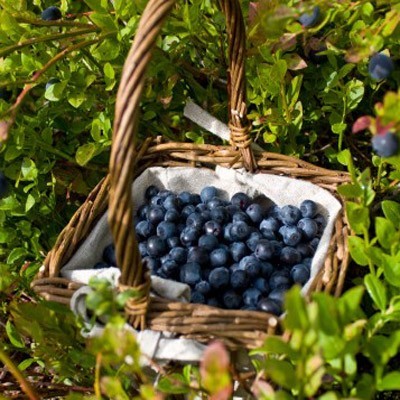
Planting several blueberry bushes is a wonderful way to incorporate edible ornamentals into your landscape. The fruits are delicious to eat and contain a broad range of health benefits, and the plant's foliage provides a great source of fall color. Here are three keys to growing blueberries successfully.
If you garden in Zone 2-9, you can find a blueberry variety suited to your growing area. There are four common variety types, each distinguished by climate suitability and ripening season. They are: Northern highbush, lowbush, half-high, and rabbiteye. Some varieties produce small yields of large berries (best for fresh eating and desserts), while others produce large yields of small berries (great for pancakes and muffins). Some have upright growth habits, and others work well as groundcovers. Many offer the bonus of brilliant fall foliage. And for gardeners who don't like the color blue, the first-ever pink blueberry, Vaccinium 'Pink Lemonade', has been developed by Briggs Nursery. www.briggsnursery.com
Northern Highbush blueberries (Vaccinium corymbosum)
Highbush blueberries (Zones 3-8), are the most common. They are native to the mid-Atlantic region and grow to heights of around 6 feet tall. Once they reach maturity, a single highbush plant can produce as much as 6 pounds of berries every year.
Lowbush or "Wild" blueberries (V. angustifolium)
Lowbush varieties (Zones 2-6) are northern natives and very cold hardy. These dwarf bushes can act like a groundcover and spread via underground stems. They produce high quality berries that are small in size, and have a distinctive "wild" flavor. Expect mature plants to yield a few cups of berries each year.
Half-high blueberries (also called mid-high)
These compact hybrids (Zones 3-7) combine the berry size of highbush blueberries with the hardiness of lowbush blueberries. They grow approximately 2 to 4 feet tall. Half-high blueberries yield approximately 3 pounds of berries per plant at maturity and all varieties produce a beautiful display of color in the fall.
Southern Rabbiteye blueberries (V. ashei)Rabbiteye blueberries (Zones 7-9) are also referred to as Southern highbush blueberries. They are native to the Southeast and are better adapted to high temperatures and drought than other varieties. Rabbiteye blueberries can grow up to 15 feet tall. Like highbush blueberries, mature rabbiteye blueberry plants produce about 6 pounds of berries per year.
Plant multiple varieties: Some types and cultivars of blueberries require cross-pollination while others are self-fertile. Even when cross-pollination isn't necessary, planting two or more varieties next to each other will encourage all of the bushes to produce bigger and better tasting berries. Also, by planting varieties that ripen at different times, you'll maintain a fresh supply of berries throughout the season.
Blueberries require soil with a pH of 4.5 to 5.0. If your soil has a pH of 7.0 or above, it's going to be challenging (although not impossible) to create the acidic environment they prefer. Start with a soil test. If you're unfamiliar with the process, contact your state's county extension agency for more information. Once you submit your sample get the results (usually within 5-7 days), amend your soil based on the lab's recommendations.
Blueberries in containers: If the soil in your area is not suitable for blueberries or your growing space is limited to a deck or patio, growing blueberries in containers is a great option to consider. Half-high and lowbush varieties work especially well for this. To create an acidic growing medium, mix together 1/3 peat moss or pine bark, 1/3 potting soil, and 1/3 builders sand. Stir in 1/2 ounce of sulfur for each cubic foot of soil. Fertilize plants with products labeled for use with azaleas, and top the pots with mulch to keep the shallow roots cool and moist. Replace the soil and prune back the roots every 3-4 years before repotting.
Pruning is one of the most important aspects of growing blueberries. Annual pruning is necessary to invigorate the plants, encourage fruit production, and prevent the bushes from overbearing. Blueberries bloom on 2 to 3 year-old branches and plants reach full production after 5 to 6 years. Annual pruning helps maintain a good supply of 2 to 3 year old branches, while removing branches that are 4 years old or more.
For the first several years, remove only weak growth and branches growing close to the soil. On mature bushes remove one-third of the oldest shoots each year, as well as any broken or diseased branches. Prune in late winter or early spring before growth begins.
Newly planted bushes should be given a full growing season to get established before allowing them to bear fruit. Remove all blooms as they appear the first year after planting. If your bushes are heavy producers, it's also good idea to remove a small portion of the flower buds each season. If you leave them all intact, you may find that your plants produce an over abundance of small, low quality fruits.

About The Author: Ellen Brown is an environmental writer and photographer and the owner of Sustainable Media, an environmental media company that specializes in helping businesses and organizations promote eco-friendly products and services. Contact her on the web at http://www.sustainable-media.com
Add your voice! Click below to comment. ThriftyFun is powered by your wisdom!
What a fantastic post, thanks so much for sharing all this knowledge. Have just read the entire thing aloud to my old man. Answered lots of our questions as to why we weren't having much sucess with our blueberries, and given us the solutions too! We are away to the woods for some pine needles this weekend.
Ayesha
Add your voice! Click below to comment. ThriftyFun is powered by your wisdom!